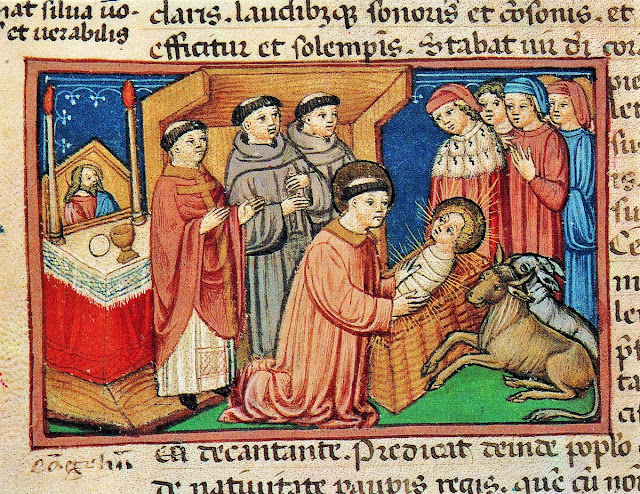XV century Greccio manuscript
Scene from Greccio, 15th century manuscript. St. Francis wears the deacon's dalmatic. We are in the choir of a Franciscan church: see the brothers' stalls, and the altar with this very primitive altarpiece.
Francisco decorates a living nativity scene: Miniature from 1400, made in Italy. Scene from Greccio, 15th century manuscript. Saint Francis wears a deacon dalmatic. We are in the choir of a Franciscan church: look at the stalls of the brothers and the altar with this medieval altarpiece.
Francis longed to imitate Christ as faithfully as possible. Anything that could help with that was welcome. In 1224, for example, he asked the Pope for permission to set up a living nativity scene. In this way, he and his followers were able to more clearly visualize the poverty of Jesus. His biography says so.
What he had especially set his mind on, what he most desired and unconditionally decided, was: to keep the holy gospel everywhere and at all times, and with the utmost awareness and full commitment to himself, with all the longing of the soul. and of the spirit. fervor of his heart, to do perfectly what our Lord Jesus Christ had taught, and to follow his example closely. Constantly meditating, he recalled his words and reflected deeply on the life of Jesus. Especially the humble stature in which he was born, and the love he showed in his suffering, captivated his attention. He didn't want to think about anything else. Therefore, I must recount and remember with reverence what he did two years before his glorious death in Greccio on the birthday of our Lord Jesus Christ.
There lived a certain Johannes, a man of good repute, whose way of life proved to be more than worth the name. Blessed Francisco had a special affection for him. Because although he was noble and highly esteemed in his circle, he himself did not attach much importance to all this, and that is why he had preferred the nobility of his soul to the nobility of his family.
About two weeks before Christmas, Francis summoned him, as he often did, and said: "If you want us to celebrate Christmas in Greccio this year, get ready quickly and do exactly what I tell you. I want the memory of the Child born in Bethlehem, and see with his own eyes as best he can the painful and needy conditions that he had suffered when he had just been born; I want to see how he lay there in a straw manger between an ox and a donkey. " When his good friend heard this, he hurried to work and made all the preparations that the saint had commanded him to make.
The joyous day was approaching, it was time to commemorate the event with joy. The brothers were invited from many places, the people of the region, men and women, happily provided torches and candles to light that night, in which a twinkling star had illuminated every day and year with its light. Finally the saint also came and was happy to see that everything had been settled. They were making a manger and putting straw in it; an ox and a donkey were also placed there. Here simplicity was honored, poverty was exalted, and humility was exalted. Greccio was like a new Bethlehem. The night was clear as day, a delight for men and animals. And they arrived, men and women, elated with unprecedented joy at the totally new way the secret was being celebrated. The forest echoed with voices and the rocks reflected the sound. The brothers sang and duly praised the Lord. It was a night full of cheers and joy. The saint of God stood before the manger, always sighing with deep pity, but also overflowing with wonderful joy. The solemn Holy Mass was celebrated on the manger and the priest felt invaded by an unprecedented emotion.
Francisco started the custom of setting up a Christmas scene.


Comments
Post a Comment